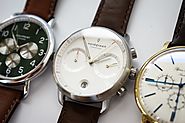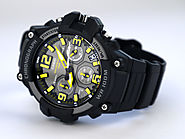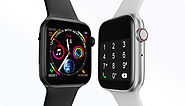-
About
- About Listly
- Community & Support
- Howto
- Chrome Extension
- Bookmarklet
- WordPress Plugin
- Listly Premium
- Privacy
- Terms
- DMCA Copyright
- © 2010-2025 Boomy Labs

Listly by keith elliot
Chronograph watches can be distinguished because they have two extra buttons which conventional watches bring. The standard thing is that you is put at 2 o'clock and the other at 4 o'clock. They also usually consist of various dials for the dimension of time and sometimes even come with a single button.
Monopulsant
These models utilize one button, which will be nothing more than a button that's added to the crown at which we fix the clock period.
Among its drawbacks is it is not as flexible as those using two push-buttons since you have to be a little patient and wait for a little between the reset and the start of the new count to prevent damaging the inner mechanism. Nor do they provide you with the flexibility of having separate buttons for each function.
Rattrapante
This design is much more complicated , it's two central hands for the next, two buttons and sometimes even a third that's contained in the primary crown. The idea is you can count two different times, one using the first hand and another with the second. That is why it can also be known as a double chronograph.
Fly-back kind
This version can be confused somewhat with the rattrapante, only that it's a basic difference: it does not count two distinct occasions, but consecutive times. It also includes two buttons, just it has the capacity to reset the counter without quitting it, which can be extremely convenient in a variety of situations.
It is also practical for fast consecutive counts since the mechanism is created so that you can prevent it, reset it and start again quickly without anything being damaged or blocked.
Factors to Think about before Purchasing a chronograph watch
The way you use it
If you have thought that chronographs only mark race times, think again.
Anything you believe could be measured with a fantastic quality chronograph, only for some, you will need more versatility and a more precise version, so if you're looking for something professional for athletics or similar activities, it's best to buy a high-end one, however if it's simply for day-to-day activities, even the cheapest will probably be more than enough.
Reading facility
If you can't read easily, it's not worthwhile. And pay close attention as there are currently many versions on the market which are hard to read simply because they look more attractive and minimalist by taking smaller amounts. So look for something with large numbers and anti-glare displays. Even if you would like to use it through the night, you'll need a model with a backlit display or carry neon on the dials.
Form of building
Each version has its operating mechanisms and costs related to maintenance, being the priciest housing to maintain. On the other hand, those of third parties are very dependable, are damaged little and their upkeep is of the cheapest. Just they are usually mass-produced, so that they do not have a lot of status and exclusivity.
Modular or incorporated layouts
Modular and integrated layouts vary slightly from one another. Modulars are advised by purists because they are designed and optimized to operate more efficiently, only they are not as accurate. On the other hand, the integrated ones are mounted onto a separate plate on the side of the dial, providing a nice display from the trunk, they are also a little more precise.
Traditional or chamber
Chronographs require mechanics to organize contrasts, detentions and retake dimensions. The traditional one is a bit more expensive to make and difficult to fix in case of harm, but they look and feel luxurious. Then there are the camera models, which are easier to produce, repair and maintenance for, but of course, they're not so luxurious. The good thing is they work just as well and with the same precision as the conventional ones.
The same goes for vertical and horizontal systems. The former is more costly and colorful, while the latter is more economical, accurate and simple.
Rate
Each clock has the ability to measure time in fractions of a second in line with the rate of its mechanisms and that rate is measured in vibrations per hour (HPV). People of 28,000 HPV measure around 1/8 of a second, while those of 18,000 HPV measure 1/5 of a second.
Tips for Purchasing a good chronograph watch
Keep it simple
Avoid versions with too complicated functions which will cost more money and you won't really use, so look for just those features you will need. But if you're searching for fashion watches, pay considerably more attention to design than anything else.
If you've got 2 or 3 pushbuttons, you will discover that everything is easier to use, and that quartz will be much more precise and easier to maintain than mechanics, so you ought to take into consideration so that your chronograph continues a great deal and to get more weather.
Look at the aesthetic
As you can wear it every day, make sure you enjoy how it appears. And since there are all fashions to choose from, take some opportunity to locate the design features that you enjoy best.
The basic parts of your chronograph
Finally, it is important you know the parts of which a common chronograph watch is composed. Remember that anyhow and, based on the price and range of the model in question, you might have various other parts or may not include all those listed in this section. Check it out so that you know what to Search for in your next purchase:
Source: https://reviewsbeat.com/best-chronograph-watch-for-men/

Chronographs remain the most coveted watch category among enthusiasts and collectors alike. It does not matter if it is sporty or elegant and in all price ranges. For this article, we have selected four special chronographs that are particularly good value for money and inspire with their classic design.

With the launch of its first watch in November 1974, Casio entered the wristwatch market at a time when the watch industry had just discovered digital technology. As a company with cutting-edge electronic technology developed for pocket calculators, Casio entered this field confident that it could develop timepieces that would lead the market.
Today, Casio is focusing its efforts on solar-powered radio-controlled watches: the built-in solar battery eliminates the nuisance of replacing batteries, atomic timekeeping means the users never have to reset the time. Recently, Casio launched a series of Bluetooth watches that sync to the users cell phone to automatically update the time. Casio is always moving time forward.
The timeless style of a 3-hand analog, with a resin combined with a heavy duty chronograph design and stopwatch make this watch both functional and stylish.
Product Dimensions: 4.2 x 3.2 x 2.3 inches
Shipping Weight: 3.84 ounces (View shipping rates and policies)
ASIN: B01GI9Z1E6
Item model number: MCW-100H-1A3VCF
Batteries: 1 Lithium ion batteries required. (included)
What people are saying about this watch
quote here
The watch is as advertised. After one week of daily use at work and after, its a great looking watch, the face has three dimensional depth that most watches at this price don't come close. Everything is working fine except the second counter on the chronograph dose not zero, and the dials are small on the chronograph and hard to read. I rearly use the stop watch so its not a deal breaker for me. Most importantly it keeps actuate time.
I will give a long-term review in the future.
Update, I found this paper that said instructions, on it. This instruction paper had many languages. It showed how to zero the stop-watch. Easy to do, fixed.
After one week or so, this thing is a great little timepiece, accurate, easy to read, comfortable, and good looker, i like reading the time on this watch.
In our guide to men's wristwatches, we discussed"complications" -- the many extra features on a wristwatch that go beyond simply telling time. A couple of the complications that you'll often see on racing or pilot watches are a chronograph and a tachymeter.
They surely make your watch seem cool, but they're not just for looks. Learning these two watch complications operate collectively can turn your view into a fairly nifty measuring tool.
If you've been mystified by all of the dials of your chronograph watch and don't have any clue what those tachymeter numbers around its bezel imply, then read on. We describe it all below.
How to Use a Chronograph
"Chronograph" is just a fancy word for"stopwatch." They have been added to watches back in the first part of the 20th century to allow racecar drivers and pilots to time themselves, and every other. Astronauts through America's golden era of space exploration strapped watches with chronographs on their wrists too. For instance, Apollo 13 astronaut Jack Swigert utilized the chronograph on his Omega Speedmaster to time a significant course correction on their perilous journey back to earth.
Employing a chronograph is simple. You simply press on the start/stop button on the face of the watch to begin or stop the stopwatch; push the bottom button to reset back to zero.
The more confusing part comes in understanding what the various sub-dials that compose the chronograph mean.
Watch chronographs usually consist of three hands: another hand, a second hand, and one hour hand. (Many chronographs have just another hand and a second hand. Here I'm using an Omega Speedmaster (supplied by Crown and Caliber) as an example, which has three chronograph hands.)
The next hand on a chronograph watch is that the long, thin center hand. Unlike the second hand on watches with no chronograph, this one only moves when you have started the stopwatch.
You could be thinking,"Where does a watch with a chronograph keep an eye on the seconds of the present moment?" That is done on among those sub-dials on an eye's face. On this Speedmaster, the second hand for the current time is about the right-side sub-dial.
Notice that the next hand in the ideal sub-dial keeps moving when the chronograph's second hand is stopped and that the chronograph's second hand just starts if you push the start button on the chronograph.
The chronograph's minute hand on this particular watch is on the left-side sub-dial. It lets you know many minutes have passed since you started using the stopwatch. As you can see, it monitors up to 30 minutes.
The chronograph's hour on this particular watch is your base, middle sub-dial. It lets you know how many hours have passed since you started your stopwatch.
How to Utilize a Tachymeter
Alright, so using a chronograph is easy. It is just a stopwatch.
Let's move on to tachymeters. Using them requires a bit of mental mathematics, but as soon as you understand how to utilize it, you'll have the ability to measure all sorts of things like speed and distance traveled, in addition to fuel consumption (if you've got a special ruler slide tachymeter bezel).
A tachymeter is a scale that's inscribed around the bezel of an eye or the outside edge of this watch's main dial. The formula to create this scale would be:
Tachymeter scale value = 3,600 (number of seconds in one hour)/elapsed time in minutes
The scale allows you to convert elapsed time (in seconds per unit) to speed (in units per hour).
Many tachymeter scales only function and are valid for several elapsed times starting at approximately 7.2 seconds and up to 60 minutes. Notice on this Speedmaster the scale starts at 500 at around the 7.2-second hash. So if you are attempting to assess the rate of something which has an elapsed period of less than 7.2 minutes, the tachymeter is not going to work for you. For things which take longer than 60 seconds to complete, it's still possible to use a tachymeter to figure out the rate, you'll just have to do some mathematics. More on that in a little bit.
Also keep in mind that a tachymeter can simply quantify known distances up to 1 full mile or 1 complete kilometer. It is possible to quantify speed for items that travel shorter or longer distances, so you simply have to do some math.
Let's take a look at how to use a tachymeter to measure speed and distance in a couple of different scenarios.
How to Use a Tachymeter to Measure Speed
To gauge the speed of an object by means of a tachymeter, you need to be aware of the established distance between 2 points. Let's say you're at a racetrack and you also understand the distance between turn 1 and turn 2 is 1 mile. With that understanding, you can measure the average speed of a car.
The moment the car passes turn 1, then push the start button on your chronograph. If it happens at turn 2, stop it. According to your chronograph, it took the car 40 minutes to go from turn 1 to flip 2.
Looking in the tachymeter on your own bezel, 40 seconds lines up with all the 91 hash mark on the tachymeter. This means the car was averaging 91 mph as it was traveling out of turn 1 to reverse 2.
It is possible to use the tachymeter for other measurement units such as kilometers too; it is a neutral scale. For example, let us say the racetrack you are in is measured in km. You know that the distance between turn 1 and turn 2 is just 1 km.
As soon as the car passes turn 1, then start the chronograph. When it reaches turn 2, stop it.
According to your chronograph, it required the car 22 minutes to go from turn 1 to turn 2. 22 seconds lines up using 180 hash mark in your tachymeter bezel, so the car was averaging 180 km/h between turn 1 and turn 2.
If you are measuring elapsed times on distances shorter than one mile or one kilometer, you need to do a bit of math to obtain the average rate. Let's say you're seeing a stock car race at Thunder Road in Barre, VT.. The track is only a quarter-mile.
You start the chronograph when a vehicle passes the start/finish line and prevent it when it completes an whole lap. It required the automobile 16 seconds to complete a lap on the quarter-mile track. 16 minutes lines up with 225 on the tachymeter scale. There's no way that car was moving 225 miles per hourto find the correct average speed, you need to keep in mind that the track was just one-quarter of a mile. We need 1/4 of 225, which is 56.25. The automobile was averaging a rate of approximately 56 mph.
What do you do if you quantify something which takes over 60 minutes? Remember, the method by which the tachymeter scale is initiated, it is only good for measuring elapsed times around a moment.
But, with a little bit of math, you can still utilize a tachymeter to measure average pace for things that take longer than that. Let's say you're watching a 1-mile horse race, and you want to know how fast the winning horse was averaging. He completed the mile in 1 minute 34 seconds, or 94 seconds.
94 seconds is too long to receive a speed with all our tachymeter. But let us judge his speed on half a mile. We can estimate it required the horse 47 minutes to complete half a mile (94 seconds divided by two = 47 seconds). 47 seconds is within the range of the tachymeter and it lines up with the 75 hash mark. To find the average rate per hour for the full mile, we must divide that 75 by two, giving us an average rate of 37.5 mph.
Aside from the speed of objects such as cars, people, or race horses, you may even use a tachymeter to figure out how much time it takes to produce"x" number of widgets in one hour. For instance, if you would like to know how many watches a watch business is able to make an hoursimply time how much time it takes to earn a watch from start to finish with your chronograph. Thanks to automation, it requires only 55 seconds. Taking a look at the tachymeter scale, 55 minutes lines up with 65. So a watch company may create about 65 watches in an hour.
Cool, huh?
How to Use a Tachymeter to Measure Distance
Besides measuring the speed of an item, you may even utilize a tachymeter to measure distance traveled.
To accomplish this, you should first know your travel speed, and that travel speed needs to stay constant.
Let's say you are cruising on the highway at 75 mph. Begin your own chronograph second hand. When the secondhand reaches 75 about the tachymeter scale, then it means you've traveled 1 mile.
Again, for this to work, your rate needs to remain constant during the entire time.
Now those dials in your chronograph watch don't have to be so intimidating, and you can actually use and appreciate them for their function in addition to their own form.

xWatch has all the usual features you would expect from such a product, but it doesn’t stop there. Read the xWatch Review.

Are you looking for EWatch review? I am sure that you must have heard about this amazing Ewatch that can make your life way too convenient for you